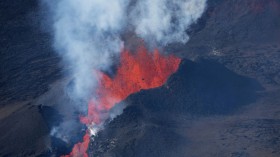Through data gathered from more than 10,000 minerals over the course of a 15-year study, scientists show the possibility that extraterrestrial life exists in the vast universe.
Information from each mineral could give more data about the origins of life, direct the search for novel minerals, and discover habitable planets and extraterrestrial life on other planets.
In a 15-year study undertaken by the Carnegie Institution for Science, every known mineral on Earth has had its origins and diversity cataloged for the first time in a 15-year study, which could pave the way for reconstructing the history of life.
Minerals formed through different interactions could also provide hints of long-extinct life or the existence of an ancient ocean. By relying on established procedures based on voluminous published literature that has not been collated into open-access data resources, the new mineral cataloging system enables better access to mineral science. 10,556 unique mineral and formation mode combinations have been found by researchers Robert Hazen and Shaunna Morrison.
5659 Minerals
A thorough examination of 5659 different mineral species and 57 different paragenetic modes reveals trends in the distribution and diversity of minerals that are related to their changing formational environments.
In stellar, asteroid, nebular, and early Earth contexts, the earliest minerals were dominated by chemical elements that were relatively abundant, particularly hydrogen, carbon, oxygen, magnesium, aluminum, silicon, sulfur, calcium, titanium, chromium, and iron.
Then, through two main processes, significant mineral diversification took place. The first involved the incremental sampling and concentration of rarer elements through fluid-rock interactions, and the second involved near-surface biologically mediated oxidative stress and weathering. For instance, complex granite pegmatites, agpaitic rocks, and hydrothermal metal deposits all use the first process.
Read also: Earth's Crust Chunk the Size of Ireland Found Below Australia
Mineral Diversity
The researchers discovered that while 1372 species or 24.2% are connected to two paragenetic modes, 3349 mineral species, or 59.2% are only known from one paragenetic context. Pyrite, hornblende, albite, corundum, calcite, magnetite, hematite, rutile, and baryte are a few of the minerals with the most genetic diversity; each of these minerals has at least 15 known modes of formation.
The paragenetic processes that affect minerals most frequently include condensation at volcanic fumaroles for 459 species, subsurface hydrothermal deposition for 859 species, and near-surface weathering or oxidation for 1998 species. Numerous species are also connected to environments of distinct igneous lithologies that are compositionally extreme, such as agpaitic rocks with 726 species, complex granite pegmatites with 564 species, carbonatites, and related carbonate-bearing magmas with 291 species.
At least 2707 mineral species are produced by biological processes, primarily through oxidative weathering, but also through 597 species of coal-related as well as other taphonomic minerals, as well as anthropogenic minerals, such as byproducts of mining including 603 minerals.
Contrary to earlier predictions, the team discovered that only 34% of the mineral species form solely as a result of biological processes. The dynamic hydrological cycle of Earth has been by far the most important factor in enhancing mineral diversity. Water-rock interactions give rise to at least 4583 different species of minerals or 81% of all species.
Possibilities of Extraterrestrial Life
The scientists also pointed out in their study that the timeline for mineral-forming processes indicates that the Earth's diversity of minerals was largely established during the first 250 million years.
This view of an early Earth with a variety of minerals offers many more credible reactive pathways across a longer time than previous models, which is important if life is relatively scarce in the universe. But if life is a cosmic requisite that emerges in every water-rich and the mineral-rich world, then these results support the idea that life on Earth rapidly evolved during the first moments of planetary evolution, Interesting Engineering reports.
Related article: Natural Recipe: How the Earth Managed to Create Thousands of Minerals Vital for Survival
© 2024 NatureWorldNews.com All rights reserved. Do not reproduce without permission.





